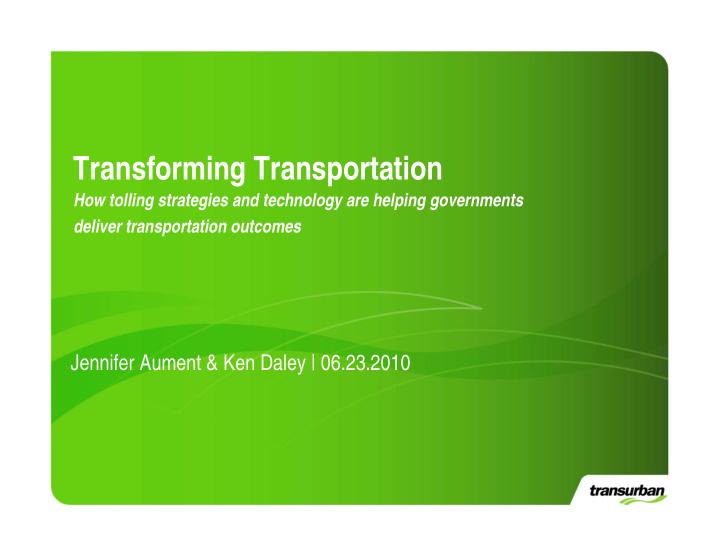



Transforming Transportation How tolling strategies and technology are helping governments deliver transportation outcomes Jennifer Aument & Ken Daley | 06.23.2010
About Transurban • Values-based, value-driven toll road owner-operator with assets and projects in North America and Australia • More than 5.1 million customers worldwide and 600 staff in offices in North America and Australia • Constructing HOT lanes on I-495 Capital Beltway • Developing HOT lanes project I-95/395 • Long term concession to manage and maintain Pocahontas Parkway in Richmond, Virginia • Interests in 5 Australian toll roads including some of the world’s most advanced and successful toll roads • Capabilities include innovative transport , road performance and safety, concession management, project development, asset enhancement, tolling and customer service, sustainability, road safety and performance, financial management 2
Tolling Technology Tolling is a form of ‘road user’ charging designed to deliver transportation outcomes: • Revenue generation • Cost recovery • Congestion management US ‘tolling’ to date has focused on improving community Various ‘tolling’ technologies accessibility and mobility deliver different outcomes. 3
All-Electronic Tolling: How it Works 4
Current Tolling Technology • Full electronic tolling, cameras, sensor systems, video vehicle identification, radio frequency/transponders Video vehicle identification Radio frequency/Transponders Light curtain laser profilers used in Germany Overhead cameras
Current Technology Driven by Outcome Needed Transponder/Tag or cash London - Video Portland, OR – GPS 6
Technology matches ‘Business Need’ Technology Application Comments Radio Frequency Road Tolling Pros: Identification (RFID) (Global) Proven technology with high accuracy also known as Low transponder costs (<$20) Dedicated Short Range Widely used – 16 million E-Zpass customers Communication (DSRC) Cons: Requires roadside gantries GPS Large National Pros: Network Proven technology with high accuracy in most Charging circumstances (Germany, Cons: Slovenia) High transponder costs (>$500) Requires dedicated enforcement resources Video Congestion Pros: Charging Cheap as no ‘on board’ units required (London) Cons: Proven technology but accuracy is limited by car tag ‘readability’ This list is not a complete analysis of technology characteristics and is meant only to provide examples.
Tolling Technology on the Horizon • 5.9 GHz, on-board units, accident avoidance, satellite/GPS, cell • Technology follows the need. Refine business requirements based on what the technology needs to accomplish.
Your Constituents, Our Customers • Business needs are defined by.... Convenience for customers Demonstrated value for money Visitors, members of the military Customer service Protecting customer privacy • Locality-specific challenges can be overcome Infrequent users Taxis Commercial vehicles
Conclusion: Implementation Considerations • Tolling Technology is available to support most operational environments • The key to successful application is the comprehensive development of the customer service and business strategies • The major variable is cost – implementation and operation to achieve the ‘business’ outcome • Legislation to support enforcement – keen focus on customer service • Self- sustaining business model • Customer service scalability and efficiency
Recommend
More recommend